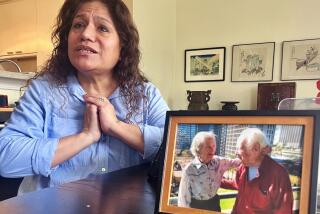Alzheimer’s Education Undertaking a Shift in Thinking
- Share via
ST. LOUIS — Ethel Shaw was the quintessential grandmother, a retired schoolteacher who spent countless hours quilting baby blankets for her great-grandchildren and baking their favorite cookies -- molasses or peanut butter.
One day she was on the phone with her granddaughter, Laura Asher, worried because she didn’t know what had become of her latest batch of cookies. Laura thought of motions similar to opening an oven door.
The cookies, it turned out, had ended up under a bed, slid back behind a dust ruffle.
Before Shaw died in June from Alzheimer’s disease at age 92, the effects of the progressive brain disorder were apparent.
Laura recalls weeping in the bathroom at a baby shower when she realized the toll the disease was taking on her grandmother. The pattern on a baby quilt from 1996, like the one just before it, had become confused, with dropped stitches and missing elements. By contrast, a 12-block Mickey Mouse design from 1991 showed flawless embroidery.
In the past, Alzheimer’s outreach efforts largely focused on getting information to care-givers looking after those with the disease, said Stephanie Rohlfs-Young, director of outreach for the St. Louis chapter of the Alzheimer’s Assn.
Today, the Asher family, like others nationwide, is using its own struggles with the disease as motivation to educate new audiences about it. Early detection can lead to treatment that can slow the illness, which afflicts 4.5 million Americans and is on the rise as the population ages.
“We used to think of Alzheimer’s as your grandmother’s disease,” said Rohlfs-Young. “But the disease affects every member of that family.”
Even the youngest can make a difference.
Laura recalled the night a few years ago when her 11-year-old son, Ian, came to an Alzheimer’s meeting with her.
“He heard the adults talking about ways to raise money and thinking outside the box and he said, ‘What about kids and schools?’ ” his mom recounted.
Ian began raising money last year at his Windsor school district, selling small, square pieces of purple paper with forget-me-not flowers printed on them that children could buy and post in their schools. A restaurant in nearby Barnhart, Ginny’s Kitchen and Custards, also started selling the forget-me-nots.
That effort and others Ian started, including an art contest, have raised about $5,000 to fight the mind-robbing disease for which the cause is unknown.
“I wanted to help find a cure for it, so nobody else has to have it,” Ian said, expressing some surprise that his efforts had caught notice.
Pat Richard Sacco, 65, a retiree in Port St. Lucie, Fla., still keeps busy volunteering with the Alzheimer’s Assn. of Southeast Florida. Both of his grandfathers had Alzheimer’s, and he had worked with many families dealing with dementia.
About five years ago, Sacco was trying to comfort a woman as she admitted her husband to the nursing home where Sacco worked. He believes it’s often better to let professionals care for Alzheimer’s patients, but recalled that the woman felt deeply guilty.
She had been sleeping on a mattress on the floor for about three years, hoping that if her disoriented husband tried to leave the bed, his movements would awaken her.
In addition to chairing a fundraising Memory Walk in his area, Sacco said his church, St. Luke’s Episcopal, had donated more than $3,000 in bingo proceeds to buy Safe Return bracelets and necklaces with identifying information that could aid in getting an Alzheimer’s patient back home. The silver-colored, metal jewelry can also alert authorities in an emergency if the wearer is a care-giver, responsible for looking after someone.
In Ohio, Monica Magette chairs the Mosaic Council for the Alzheimer’s Assn. of Greater Cincinnati, which educates races and cultures about the disease.
More to Read
Sign up for Essential California
The most important California stories and recommendations in your inbox every morning.
You may occasionally receive promotional content from the Los Angeles Times.













